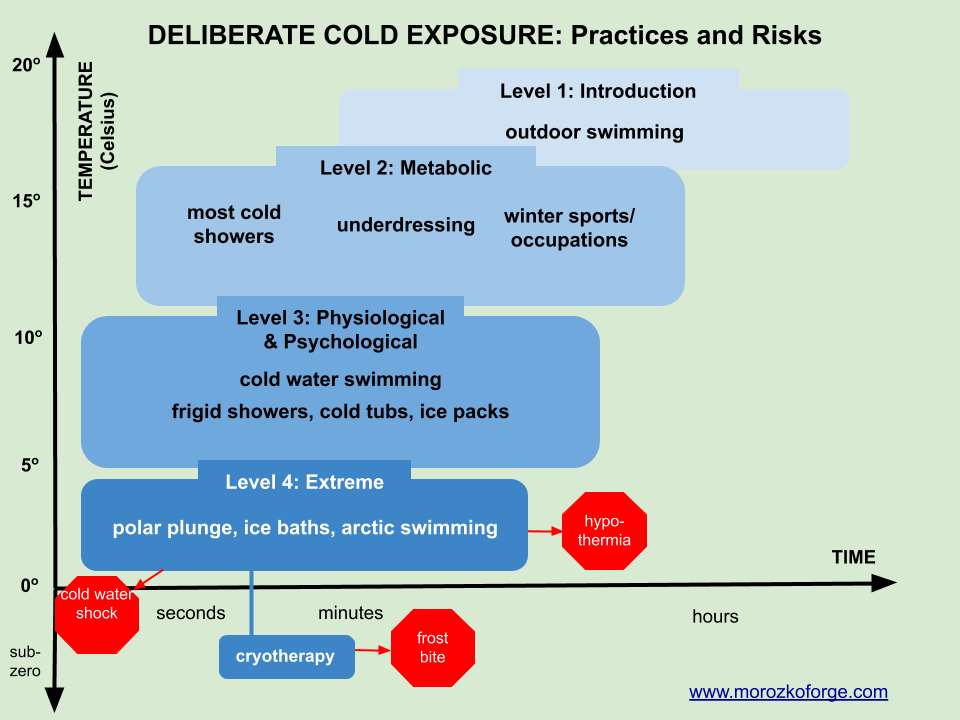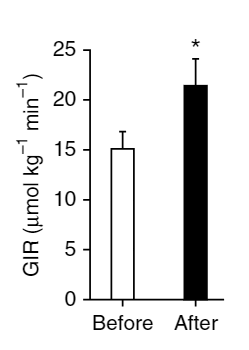By Thomas P. Seager, PhD
The reasons to begin a regular practice of deliberate cold exposure are multidimensional and complex, including relief from pain and inflammation1, muscle gain and hormonal rebalancing2, increased insulin sensitivity and metabolic health3, autoimmune regulation4, accelerated ketogenesis for cancer control5, and psychological resilience for stress management6. However, the methods by which people begin cold therapy are similar and simple. It is recommended to reacclimatize to cold exposure slowly, to get used to the idea of being cold, before you move on to more advanced practices.
Benefits and Risks of Cold Therapy at Different Levels
Figure 1 below summarizes some of the methods for beginning a deliberate cold exposure practice, and some of the risks that are experienced at more advanced levels.

Level 1: Introduction to Cold Exposure
During hot summer months, people seeking to cool off will eventually find their way to the beach, pool, lake, mountain stream — or backyard sprinkler. Along the entire Pacific coast, the North Atlantic, and even the Great Lakes, water temperatures will be cold enough to promote some of the benefits of cold therapy. In this way, most people have fond memories of experiences with cold water — especially as children.
One of the reasons we grow more sensitive to cold water swimming as we age is because our bodies gradually lose the brown fat that kept us warm as babies. Because brown fat is packed with mitochondria for energy production, they are the key to supercharging our metabolism and maintaining thermoregulation during cold exposure. Without regular exposure to cold temperatures, our bodies adapt by gradually shrinking stores of brown fat until there’s hardly any left when we reach adulthood. Children, on the other hand, haven’t lost all their brown fat yet, so they typically are more comfortable in colder weather, despite the fact that they have a larger surface area to body mass ratio.
Although it takes exposure to frigid temperatures to recruit new brown fat, it may be that periodic cold water swimming is enough stimulation to prevent the loss of existing stores, and any water body that feels cold enough to make you shiver is probably sufficient to get you re-accustomed to more advanced methods of cold therapy, at which greater metabolic benefits are found.
Level 2: Cold Therapy for Metabolic Regulation

Most adults in modern, industrialized, Western societies suffer to some degree from metabolic syndrome. As Benjamin Bikman, PhD explains in Why We Get Sick7, the root cause of eight of ten leading causes of death in the United States is too much insulin in the bloodstream — a condition called hyperinsulinemia.
There are several behavioral and lifestyle changes we can adopt to correct our insulin levels, including reducing carbohydrates in the diet and increasing exercise. However, the fastest way to clear glucose from the bloodstream and improve insulin sensitivity is cold therapy. In just ten days of mild cold exposure without exercise or diet restrictions, a cohort of middle-aged German men with type 2 diabetes noticed improvements in glucose infusion rate of up to 80%.
These metabolic benefits are obtainable at the next level of cold therapy practice, where temperatures go a little lower. Winter underdressing, cold showers, or winter sports like skiing and ice skating can accomplish the same results as the mild cold exposure in the German study.
If you think a career in holistic medicine is something you would like to pursue, contact us and speak to an admissions representative to get started on your new journey!
Level 3: Psychological Benefits
While the metabolic benefits of cold therapy are obtainable at mild temperatures for promoting shivering, the psychological benefits don’t start until temperatures that will create an anxiety response are reached. One of the standard psychological tests of stress response is called the cold pressor test, and it require immersion of the subject’s hand in a bowl or bucket of ice water — cold enough to activate the autonomic nervous system to create involuntary physiological and psychological reactions.
Only freezing temperatures are sufficient to frighten the body into an involuntary gasp reflex, vasoconstriction of the outer blood vessels, and increased heart rate. At this level of cold therapy, it is essential that the cold exposure is deliberate. That is, accidental or unintentional cold exposure will stimulate metabolic responses, but may create the wrong psychological stress response by amplifying fears, rather than inoculating against them. Some brave athletes, models, and body builders using cold therapy for pain or inflammation may fail to master the art of deliberate cold exposure without an experienced guide. Although they might tolerate two or more minutes in the cold, their competitive training sometimes causes them to remain in an activated state for their entire cold plunge, thus missing the opportunity to strengthen the parasympathetic (rest and digest) response responsible for calming the brain and body back down.
Level 4: Extreme Cold Therapy
The most advanced level of cold therapy is where subjects will encounter the greatest dangers and the coldest temperatures. For example, cryotherapy and ice baths are both representative of the extreme level of cold therapy, but the risks can be different.
Cryotherapy typically takes places in a chamber of liquid nitrogen or chilled air that reaches temperatures of -150°F or less. When exposure exceeds just a few minutes, the risk of frostbite can become serious, because immersion in air so cold is sufficient to freeze the water inside the outer layer of skin cells. By contrast, cold water immersion in an ice bath can never reach temperatures much lower than 32°F — even in ice baths treated with Epsom salt. The warmer temperatures of the water (compared to cryochambers) eliminate the risk of frostbite and allow longer exposure times. However, the risk of longer exposure is hypothermia, in which the core body temperature can drop one or more degrees below the normal 98.6°F. At such low body temperature, rewarming can require a painful period four or five times longer than the exposure time.
Perhaps the greatest danger to extreme cold therapy is called the mammalian dive reflex—a potentially deadly phenomenon that can happen when plunging face-first into icy cold water. The dive reflex takes place when the cold water shock of sudden immersion initiates a gasp response while the breathing passages (nose and mouth) are underwater. An involuntary intake of cold water can result, filling the lungs and drowning the victim.
To prevent risk of the dive reflex, Morozko recommends entering the ice bath feet first, always, and to avoid submerging the nose and mouth face down in the Forge. Only Wim Hof and some Navy SEALS, who are among the most advanced practitioners of deliberate cold exposure in the world, need take the risk of holding their breath under icy water.
References
Featured Posts:

